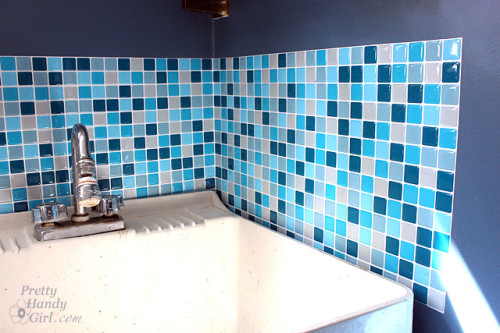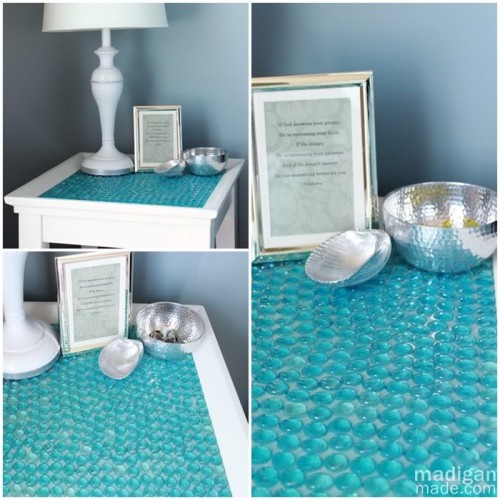Few items in the home are as versatile as bathroom tiles. There has been incredible progress in the tile industry over the last few years and they are available in a wide variety of shapes, colors and sizes, with different finishes and are made from various materials. Tiles can be made from ceramic, terra cotta clay, PVC, glass or other materials. And in fact, there are also some really smart ideas that will help you cover up old tiles that may be outdated, like Smart Tiles which are less complicated and messy to install but still look just like real tiles. And make it really easy to change the look of a room without a lot of hassle.

Source: Pretty Handy Girl
Tiles have been used for years to cover backsplashes in bathrooms and kitchens and bathroom walls have been covered from floor to ceiling with tiles because they are easy to keep clean. In fact, in Germany, people regularly tile all of the wall space in bathrooms to prevent moisture problems and keep bathrooms low maintenance. The finishes are impervious to mold, moisture or insect damage. They are also wonderfully easy to maintain as flooring and even as countertops.
Get more creative with tiles
But bathrooms and kitchens are not the only places tiles are useful. They can be used to create custom furniture such as tile covered tables, dressers, desks and more. Gift boxes or trinket boxes can display hand painted tiles on the lid and perhaps the sides. Outdoor kitchens can also feature tiled counters and backsplashes.

Source: Madigan Made
It is not hard to install tiles on various surfaces. The proper tile adhesive is spread over the surface, a few square feet at a time. When large areas are covered, level and straight lines are often marked first to keep things looking proper. But you can also add curved lines if you want a more unique, interesting effect.
The tiles are set in place by hand and the adhesive is allowed to dry for at least 24 hours. Grout, either in a contrasting or similar color, is then applied between the tiles to create a waterproof barrier over the surface. Once dried, the excess is removed and the area is ready for use. (But don’t let the grout sit too long or it become really tough to clean off — we learned that the hard way a few years ago!) Sealers can be painted over the grout to retard mold growth and prevent staining.
Tiles will last up to a hundred years if proper maintenance, cleaning and care. The average homeowner or DIY’er can easily learn to install tile in a bathroom, saving hundreds to thousands of dollars in labor costs. We installed tiles in our guest house bathroom and were really pleased with the results. While laying really large tiles is hard work (just because the tiles are so heavy), we found that tiny tiles on nets, wall tiles and even 1x2ft floor tiles weren’t all that difficult, especially with the invention of plastic spacers that help you make sure you leave plenty of room for grout!
Have you ever laid your own tile in your bathroom or kitchen? Share your experience and advice with us!
Feel free to visit my disclosure page if you have questions about this post or any other posts on NOH.



Beautiful – absolutely does make a positive difference